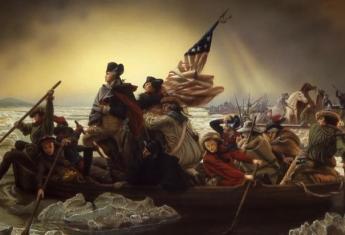Collecting Rare Books and First Editions - Dining Revolutionary Style

By Kristin Masters
On July 4, we traditionally celebrate Independence with fireworks and barbecues. But General Washington and his troops certainly didn’t have grilled chicken or barbecue ribs. Soldiers of the colonial era were lucky to receive basic rations, and inadequate nutrition was a significant concern for commanders on both sides of the Revolutionary War.
Revolutionary Rations
In 1775, the Continental Congress established the first formal food program in the colonies. The goal was to standardize both ration themselves and the ways that food was prepared for the troops. The Congress specified that each soldier receive set rations each week:
? 1 lb of beef or 3/4 lb of pork or 1 lb of salted fish
? 1 lb of flour or bread
? 1 pt of milk or payment of 1/72 dollars
? 1 qt of cider or spruce beer
? 3 pt of peas or beans
These supplies were issued for either individual or group preparation. It wasn’t until 1777 that standards governed company-level cooking, with emphasis on proper preparation and personal cleanliness. Large cooking pots were issued as part of standard equipment, to ease preparation.
Yet procuring adequate supplies proved a constant problem. Suppliers often failed to deliver products, or they brought inferior products. In some cases, they even tried to charge the military higher prices than they charged civilians. Overpricing got so serious that in May 1776, the Continental Congress had to regulate the price of salt, necessary for preserving meats and other foods in the absence of refrigeration. Meanwhile, continental currency had been so devalued, farmers were reluctant to sell their crops to commissary soldiers – they didn’t want to be left with worthless bills.
By 1777, the food shortage had become a serious emergency. George Washington wrote to President of Congress Henry Laurens “I do not know from what cause this alarming deficiency or rather total failure of Supplies arises; But unless more Vigorous exertions and better regulations take place in that line, and immediately, this Army must dissolve.” By this point, Washington’s troops were nearly starving at Valley Forge.
British Rations
Unlike their colonial counterparts, the British soldiers were never responsible for their own cooking. The company was issued collective rations, which were then used to prepare food for the entire company. Once a week, each company received the following rations per man:
? 7 lbs of flour, which was cooked into 4-lb loaves; each man received two loaves per week
? 4 lb of pork or 7 lb of beef
? 6 oz of butter
? 3 pt of pease or oatmeal
? 1/2 lb of rice
In 1775, British soldiers stationed in the colonies also received one-half pound of sauerkraut per week, which was meant as an anti-scorbutic supplement. Later in the war, soldiers in Rhode Island were actually issued a full two pounds of sauerkraut per week. Most of the sauerkraut supply had been shipped over from Cork, Ireland in 1775.
These rations seem incredibly generous compared to those that the Americans received. But the British didn’t maintain any control over the countryside they occupied. Moreover, they had few sympathizers there. Thus they had to rely on what they could forage and what was sent over from Britain. Rations were purchased by the Department of the Treasury, usually through a contractor who negotiated directly with Irish farmers. Shipments were often delayed, and the food frequently spoiled either partially or completely during transit. Flour arrived molded or rotten, and meat wasn’t much better.
Ultimately the Revolutionary soldiers had the upper hand, as they knew the land and had better access to homegrown supplies. But it’s interesting to consider the role that food and nutrition played in a war that changed history forever.
(Posted on Lizzyoung Bookseller.com, the blog and website of Elizabeth Young, antiquarian bookseller specializing in anything and everything associated with the wonderful world of food and drink. Presented here by permission of Elizabeth Young and Kristin Masters. Picture: Courtesy of the George Washington Photo Gallery)
You are interested in the history of America?
>>> Browse the ILAB Metasearch
